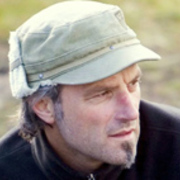
David Paul
After training as a film cameraman at state broadcaster the NZBC, David Paul continued his cinematic apprenticeship in suburban houses and emergency wards, helping film reality shows like Hospital, Home Front and Location Location Location. At the same time he had already begun shooting the first of more than 30 documentaries, including 1996 Māori land claim doco One Land Two Peoples.
Paul’s doco work includes shooting images of ballet (Black on Red and 50 Years on their Toes), architect Ian Athfield (Architect of Dreams) and meat pies (the “beautifully filmed” Who Ate All the Pies). In 2004 he travelled to Tokelau with brothers Jason and Kris Fa’afoi for acclaimed return home documentary Long Lost Sons. The programme won Paul a nomination for his camerawork at the 2005 NZ Screen Awards.
By now Paul had begun branching out into other genres. He had already helped out on camera duties on sci-fi hit The Tribe and comedy series Love Bites, and in 2004 he was asked to be director of photography for multiple seasons of fast-turnaround sketch show Facelift. The job was made more challenging by the fact that many of the cast acted under prosthetic makeup.
Paul went on to work as director of photography on episodes of the innovative and stylish drama series The Insiders Guide to Happiness. The following year he took on the lion's share of D.O.P. duties for prequel show The Insiders Guide to Love, before adding a third ensemble drama from the Gibson Group stable to his CV: The Hothouse. The trio of dramas would result in three best camera nominations at the Qantas TV awards.
Paul had not forsaken documentary entirely. Immigration series Here to Stay took him around the world, while award-winning Gaylene Preston doco The Time of Our Lives saw him travelling to England, alongside 32 war veterans. Undercover, a three-part examination of the world of undercover policemen, would again take him within inches of the winner’s podium at the Qantas TV Awards.
By 2008 Paul was expanding into feature-length projects. He shot images for the second unit on Preston’s Home by Christmas, and Show of Hands. In 2009 he finally scored his Qantas award — as cinematographer on TV movie Until Proven Innocent. It was based on the true story of David Dougherty, imprisoned and later pardoned for the rape of an 11-year-old child. Paul followed it with period romance Tangiwai - A Love Story, and Springbok tour tale Rage. He was nominated for both tele-movies, winning for Tangiwai.
Tele-movies litter Paul's CV; he has gone on to handle the images for projects inspired by the Rugby World Cup, pacifist Archibald Baxter, Scott Watson and Helen Milner (Catching the Black Widow). He also shot miniseries Hillary and episodes of the TV version of action drama The Dead Lands.
Paul's first director of photography credit on a feature film dates back to 2012 family comedy Kiwi Flyer. The film revolves around a boy who sets out to win the Nelson trolley derby, in memory of his late father. Paul followed it by shooting conspiracy thriller The Cure and teen series Girl Versus Boy; the latter project reunited him with Thomas Robins and David Stubbs, the directors behind Emmy-nominated net series Reservoir Hill.
Having earlier made a doco on Margaret Mahy, Paul's television work includes the distinctively earth-toned palette of fantasy Kaitangata Twitch, based on the Mahy novel. Directed by Yvonne Mackay, the series premiered on Māori Television in 2010, and went on to win many awards. More awards followed for Paul's work on The Banker, the Escorts, and the $18 Million, a documentary on bank fraudster Stephen Versalko, and 2016 TV movie The Dance Exponents - Why Does Love?
He went on to film Leanne Pooley's The Girl on the Bridge. The feature documentary follows suicide survivor Jazz Thornton, as she finds a way to tell the story of a friend who didn't make it.
Paul has also taken on a very different role: as presenter of Yvonne Mackay-directed doco Painting with Light - Brian Brake Rediscovered. Paul took viewers through some of the ground-breaking methods used to achieve Brake's images.
Paul has worked extensively on both film and video. He has shot images on 16mm, 35mm, Digibeta, HD and with the digital RED camera. On the musical front, his CV includes shooting concert footage of Split Enz and the Eurythmics, and directing four videos for Auckland rockers Tourist..
Profile published on 19 August 2009; updated on 18 April 2020
Sources include
David Paul - Cinematographer website. Accessed 18 April 2019
Interview with David Paul - Onfilm, May 2009